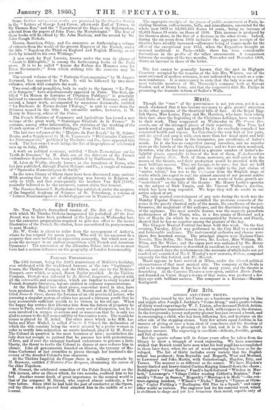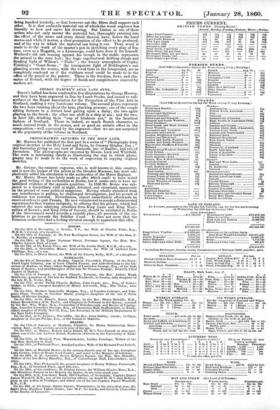/kr 9,rts.
LONDON ART-UNION PRINTS.
The prints issued by the Art-Union are a handsome engraving in line and stipple after Joseph J. Jenkins's " Come Along," and a quarto volume of thirty wood engravings by W. J. Linton, after deceased British Artiste. Jenkins's picture represents a scene in a field, with reapers in the distance. In the foreground a young and pretty gleaner has just crossed a brook, and is encouraging a child, who has been following her, and hesitates on the other side of the stepping. stones. Very few artists equal Jenkins in his manner of giving at once a beau ideal of comeliness and the freedom of nature : the incident is pleasing of its kind, and it is in the artist's happiest manner. The engraving is excellent—delicate, forcible, genial, and full of colour.
But the quarto volume will in future years often be taken from the library to show a triumph of wood engraving, We have sometimes wished that Bewick could have seen what his best pupil has accomplished in these later days, when the art of wood engraving has been so far de- veloped. The list of thirty includes every variety that the English school has produced ; from Reynolds and Hogarth, West and Morland, to Lawrence and John Martin, with Gainsborough, Hayden, Etty, and Turner. The manner is as different as the names. We have Haydon's heavy-limbed and heavy-tinted Cortina flinging himself down the chasm ; Boddington's " Coast Scene," Fuseli's hard-featured " Witches in Mac- beth," Liverseege's "Village Cobler reading Cobbett's Register," Nay- smith's "Scene in Sussex," Hogarth'a "Marriage?' Is Mode "—the con- tract-signing inoident, "Wilson's " Niobe," Barry's "Victors at Olym- pia," Copley Fielding's " Burlington Old Pier in a Squall," and many other works as various. The engraver had for his material wood, which is stubborn to shape and yet less tenacious than metal, capable only of being handled tenderly, so that however cut the fibres shall support each ether. It is that unductile material out of which the wood engraver has literally to hew and carve his drawing. But Linton is one of those artists who not only master the material but, thoroughly entering into the effect of the scene and every detail thereof, have, before the hand moves and while it moves, a clear perception of the effect to be produced, and of the way in which the material can bring it out. Thus, wood is made to do the work of the master's pen in sketching every play of fea- ture, even as a Hogarth, or a Liverseege, could have done it for himself. Morland's old cob leaning against his trough in the stable represents the animal to the very hair ; the huge supernatural drifting clouds and flooding light of Wilson's " Niobe ' ; the breezy atmosphere of Copley Fielding's " Coast Scene;" the transparent light of Boddington's sun glancing across the waters, with the vivid tints in the foreground, are as completely rendered as if the stubborn wood could be made to do the office of the pencil or the palette. There is the freedom, force, and cha- racter of Bewick, with the degree of finish and completeness exacted by modern art.



























 Previous page
Previous page